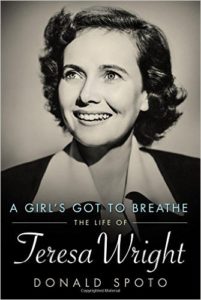Book Review: A Girl’s Got to Breathe: The Life of Teresa Wright
A Girl’s Got to Breathe: The Life of Teresa Wright
Donald Spoto
Jackson, MS: University Press of Mississippi, 2016
ISBN 978-1628460452
263 p.
Movie and Broadway stars come in all sizes and shapes. A rare few excel both on screen and the live stage, all of which makes the strange case of Teresa Wright (1918-2005) all the more baffling. Why is she so little remembered today? Following a stint in Our Town on Broadway in 1938 (with frequent subsequent returns to the stage), Wright made her Academy Award-nominated screen debut in The Little Foxes (1941), followed by Oscar nominations for her next two films, Mrs. Miniver, for which she won the award, and The Pride of the Yankees, both released in 1942. Over the next fifty-six years, Wright appeared in another twenty or so films and acted regularly on stage, but despite consistent acclaim, Wright is rarely listed among either screen greats or stage legends. Reading this first biography of Wright by Donald Spoto, her relative obscurity becomes even more difficult to understand, as Spoto makes a strong case for her importance and quality.
Wright made an auspicious movie debut perhaps equaled only by that of Orson Welles. Scoring three Academy Award nominations out of her first four performances was unprecedented (and has not been equaled since), though Wright’s admirers may be surprised to note that perhaps her finest performances, in Alfred Hitchcock’s Shadow of a Doubt (1943) and William Wyler’s World War II classic The Best Years of Our Lives (1946), went unacknowledged by the Academy. Spoto, a close friend of Wright and an unabashed admirer, explains the lack of acknowledgment for Wright as resulting from her being an uncommonly strong-minded, highly intelligent actress who refused to fit into the typical Hollywood template. The perfect defense for this was her contract with producer Sam Goldwyn, which stipulated that no “glamour girl” cheesecake photographs or made-up bally-hoo about her personal life would be permitted. More importantly, Wright was exacting in her choice of projects and co-workers, often passing up on the sort of ingénue roles typically handed attractive young actresses.
Wright’s initial blitz on the screen slowed considerably after disputes with the controlling Goldwyn and her strenuous avoidance of the public limelight. Her privacy demands almost certainly resulted from a heartbreaking childhood in poverty with a prostitute mother who failed to shelter her daughter from the harsh realities of that life. However, Wright chose intellectual companions, including her accomplished two husbands, screenwriter Niven Busch and playwright Robert Anderson. Wright’s dignified and deeply human screen persona, with an emphasis on substance over glamour, allowed her to develop as something other than a commodity. Spoto’s view of her as a singular artist among movie icons is demonstrated, in part, by her comfortable transition into a distinguished character actress.
For those fortunate to have seen Wright onstage (this reviewer saw her performances as Linda Loman opposite George C. Scott’s Willy Loman in a 1975 revival of Arthur Miller’s Death of a Salesman and in the surprise hit revival of Paul Osborn’s 1939 flop, Morning’s at Seven, in 1980), the luminous intelligence, emotional availability, and dry humor on display in her best screen roles were vividly present in the live theatre. To be remembered as an uncommonly fine actress would undoubtedly have pleased Wright, as Spoto makes clear in this highly readable and warmly generous book. Readers will be reintroduced to a star whose film work stands the most stringent test of time, revealing an actress who “pushed the conventions of glamour clean off the stage and screen, bringing a quality of naturalness, of immediacy, of – yes – honor to the human qualities she found in a role.” (p. 227)
James Fisher
The University of North Carolina at Greensboro

